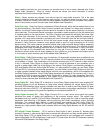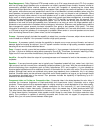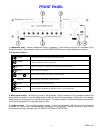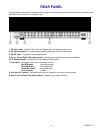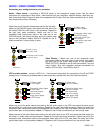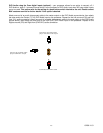
13258 11/01
8
Bass Management -
Dolby Digital and DTS formats contain up to 5 full range channels plus LFE. Only a system
with five full-range (large) speakers plus a subwoofer can directly reproduce these formats. However, almost all
commercially available center channel speakers are small and incapable of reproducing the lowest bass
frequencies without distortion or even damage to the speaker. Many people also use small speakers in the rear of
their system, while others use small speakers all around. Use of a subwoofer is almost mandatory when using five
small speakers, but people with at least two large speakers may or may not choose to use a subwoofer. Some
people may not use a center channel or surround speakers at all. In order to handle any possible combination of
large, small, or missing speakers, a home theater system must contain good bass management, a concept often
missing from two-piece systems where the Dolby Digital or DTS decoder is separate from the preamp. Your
processor contains a complete bass management system. You can use as few as two large front left and right
speakers or two small left and right speakers plus a subwoofer or as many as seven full range speakers plus a
subwoofer or any combination in between without missing any information. Wherever small speakers are used the
bass management system prevents low bass information from going to that speaker (“high pass”). This bass
information is rerouted to a speaker that can handle it, usually a subwoofer, but it can also send center, surround,
or LFE bass to large front speakers if no subwoofer is available. When center or surround speakers are not used
at all, the missing channel is sent (“down mixed”) to the front speakers.
Preamp -
A preamp typically includes the capability to select from a number of sources, adjust volume levels and
route the data to an amplifier. Your processor includes a high quality preamp.
Processor -
A processor typically includes the capability to decode one or more surround formats, and convert
between digital and analog as required. Your A/V system controller includes a high quality processor capable of
decoding the surround formats described above.
Zone -
A zone is usually a room that has speakers installed in it. Your processor includes a full preamp/processor
for Zone 1 (A) plus an additional analog stereo preamp for Zone 2 (B). This allows, for example, watching a Dolby
Digital movie in zone one while simultaneously using the built-in AM/FM tuner in another room.
Amplifier -
An amplifier takes the output of a preamp/processor and increases its level to that necessary to drive
a speaker.
Speakers
- A surround sound system use to typically use 5 speakers located left front, center front, right front,
right surround, and left surround plus a subwoofer located anywhere in the room. With the new developments in
surround technology from companies such as Dolby Laboratories, DTS, and Lucasfilm, it is now possible to
improve spatial expressions with an additional channel of information for use with a 6th and/or 7th surround back
speaker. Although best results are achieved using seven large speakers plus a subwoofer, this is not always
practical. Excellent results can be achieved using small and/or fewer speakers, as long as you go through the set
up procedures described later in the manual. Your processor includes the capability of reproducing up to 6.1
channels of surround information.
Component video vs. S-video vs. Composite video -
Composite video is the oldest standard for color video. It
combines the luminance (brightness or black-and-white) and chrominance (color) information onto a single
conductor. These signals must be separated again for display resulting in some degradation of the video quality.
S-video is a newer standard that uses separate conductors for the luminance (Y) and chrominance (C)
information resulting in better video quality. Component video is the newest form of video introduced with DVD.
This video format uses separate conductors for luminance (Y), red - luminance (R - Y), and blue - luminance (B -
Y). Using these signals a component video capable monitor allows for even better and higher resolution video
quality. Your processor is capable of switching composite and S-video with no support of component video
signals. Also, you unit cannot convert between video types.









